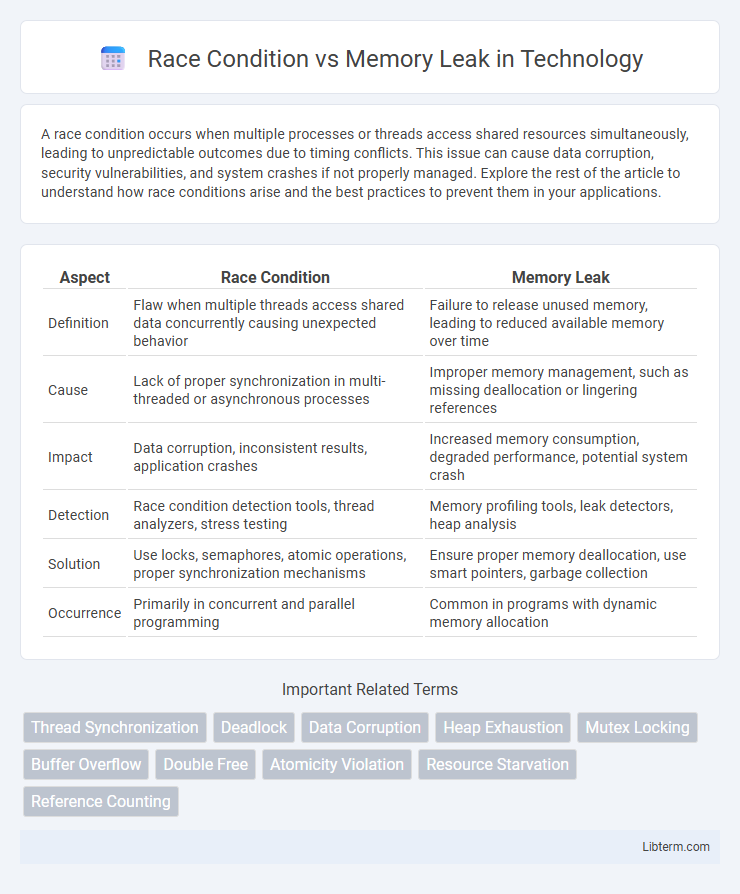A race condition occurs when multiple processes or threads access shared resources simultaneously, leading to unpredictable outcomes due to timing conflicts. This issue can cause data corruption, security vulnerabilities, and system crashes if not properly managed. Explore the rest of the article to understand how race conditions arise and the best practices to prevent them in your applications.
Table of Comparison
| Aspect | Race Condition | Memory Leak |
|---|---|---|
| Definition | Flaw when multiple threads access shared data concurrently causing unexpected behavior | Failure to release unused memory, leading to reduced available memory over time |
| Cause | Lack of proper synchronization in multi-threaded or asynchronous processes | Improper memory management, such as missing deallocation or lingering references |
| Impact | Data corruption, inconsistent results, application crashes | Increased memory consumption, degraded performance, potential system crash |
| Detection | Race condition detection tools, thread analyzers, stress testing | Memory profiling tools, leak detectors, heap analysis |
| Solution | Use locks, semaphores, atomic operations, proper synchronization mechanisms | Ensure proper memory deallocation, use smart pointers, garbage collection |
| Occurrence | Primarily in concurrent and parallel programming | Common in programs with dynamic memory allocation |
Understanding Race Conditions: Definition and Causes
Race conditions occur when multiple threads or processes access and manipulate shared data concurrently without proper synchronization, leading to unpredictable results. These issues arise from timing errors where the system's behavior depends on the sequence or timing of uncontrollable events, especially in multithreaded or parallel computing environments. Common causes include unsynchronized access to shared resources, improper locking mechanisms, and inadequate handling of concurrent operations.
What is a Memory Leak? Key Concepts Explained
A memory leak occurs when a computer program incorrectly manages memory allocation, causing memory that is no longer needed to remain allocated and unavailable for reuse. This results in decreased system performance or even crashes as the available memory diminishes over time. Key concepts include unused memory retention, failure to release allocated memory, and progressive resource depletion in software applications.
Core Differences Between Race Condition and Memory Leak
Race conditions occur when multiple threads access shared resources concurrently, causing unpredictable behavior and data corruption due to timing issues. Memory leaks arise from improper memory management, where allocated memory is not properly released, leading to increased memory consumption and potential application crashes. The core difference lies in race conditions affecting program correctness and synchronization, whereas memory leaks impact system performance and resource availability.
Examples of Race Conditions in Real-world Applications
Race conditions frequently manifest in multithreaded banking applications where simultaneous transactions on an account can cause inconsistent balance updates. In web servers, race conditions may lead to incorrect session handling when multiple requests try to modify shared session data concurrently. Real-time multiplayer games also suffer from race conditions when multiple players' actions are processed in parallel, causing desynchronized game states and erratic gameplay behavior.
Memory Leak Scenarios: Common Symptoms and Risks
Memory leaks occur when a program unintentionally retains memory, causing resource exhaustion and degraded performance over time. Common symptoms include increasing memory usage, system slowdowns, and eventual application crashes or unresponsiveness. Risks of memory leaks encompass reduced system stability, heightened operational costs, and potential data corruption in long-running applications or systems with limited memory.
Impact of Race Condition vs Memory Leak on System Performance
Race conditions create unpredictable behavior by allowing multiple threads to access shared data simultaneously, often leading to data corruption and system crashes, severely degrading system performance and reliability. Memory leaks steadily consume available memory resources, causing increased memory usage, reduced application responsiveness, and eventual system slowdown or failure due to resource exhaustion. While race conditions impact real-time data integrity and can cause abrupt failures, memory leaks degrade performance gradually, leading to longer-term stability issues.
Detecting and Debugging Race Conditions
Detecting race conditions involves identifying concurrent threads or processes accessing shared resources without proper synchronization, often revealed through inconsistent program behavior or intermittent crashes. Tools like thread analyzers, static code analyzers, and dynamic race detectors (e.g., ThreadSanitizer) assist in pinpointing race conditions by monitoring thread interactions and memory access patterns. Debugging requires isolating critical sections, applying locks or atomic operations, and reproducing the issue consistently to validate synchronization fixes.
Identifying and Mitigating Memory Leaks
Memory leaks occur when a program fails to release unused memory, leading to increased consumption and potential system crashes. Identifying memory leaks involves monitoring memory usage over time with tools like Valgrind, AddressSanitizer, or built-in profilers in development environments. Mitigation strategies include proper resource management, using smart pointers in C++, avoiding circular references in languages with garbage collection, and rigorous code reviews to ensure objects are correctly disposed.
Best Practices to Prevent Race Conditions and Memory Leaks
Implement thread synchronization techniques like mutexes and locks to prevent race conditions by ensuring atomic access to shared resources. Use memory management tools such as smart pointers and automatic garbage collection to detect and avoid memory leaks effectively. Regular code reviews and dynamic analysis tools like Valgrind or ThreadSanitizer enhance detection and prevention of concurrency issues and memory inefficiencies.
Conclusion: Ensuring Robust and Efficient Code
Race conditions and memory leaks are critical issues that undermine software reliability and performance. Implementing thorough synchronization mechanisms and regular memory profiling helps prevent concurrent access errors and resource wastage. Prioritizing these practices ensures robust, efficient code capable of handling complex, real-world applications.
Race Condition Infographic

 libterm.com
libterm.com